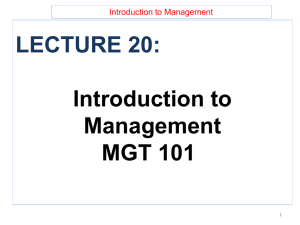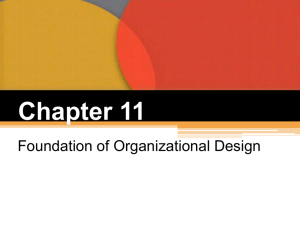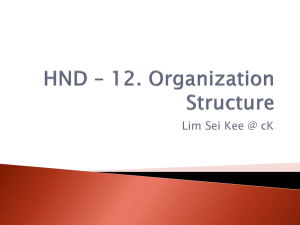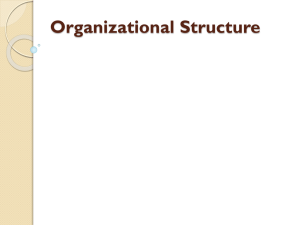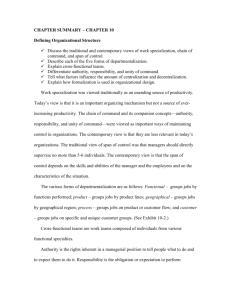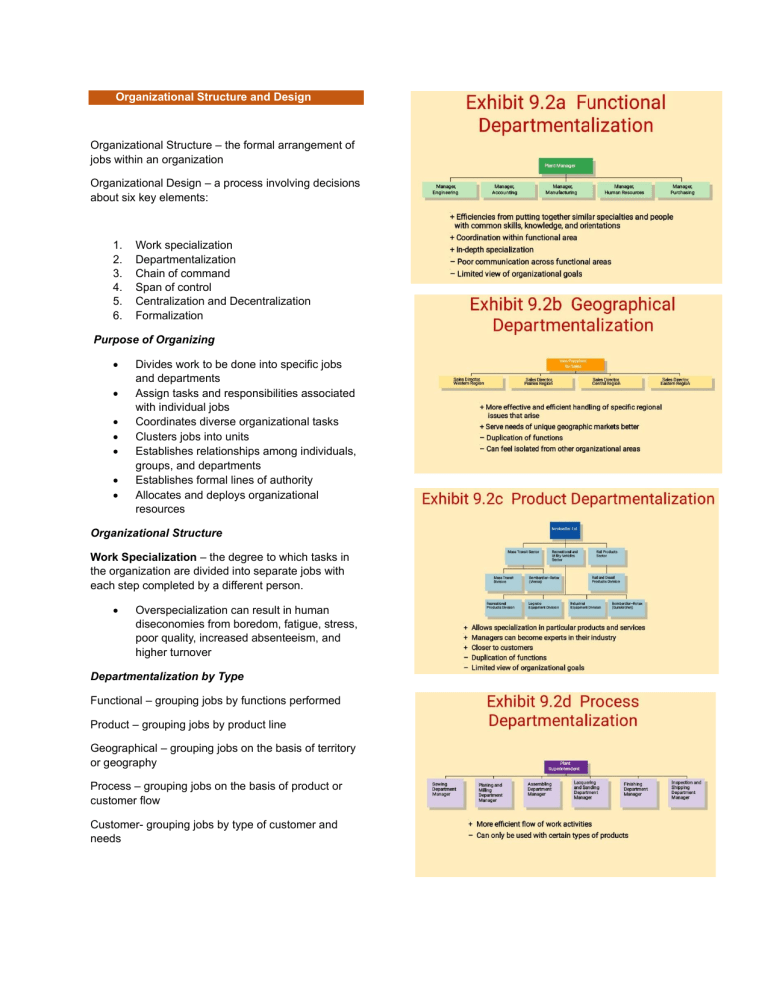
Organizational Structure and Design Organizational Structure – the formal arrangement of jobs within an organization Organizational Design – a process involving decisions about six key elements: 1. 2. 3. 4. 5. 6. Work specialization Departmentalization Chain of command Span of control Centralization and Decentralization Formalization Purpose of Organizing • • • • • • • Divides work to be done into specific jobs and departments Assign tasks and responsibilities associated with individual jobs Coordinates diverse organizational tasks Clusters jobs into units Establishes relationships among individuals, groups, and departments Establishes formal lines of authority Allocates and deploys organizational resources Organizational Structure Work Specialization – the degree to which tasks in the organization are divided into separate jobs with each step completed by a different person. • Overspecialization can result in human diseconomies from boredom, fatigue, stress, poor quality, increased absenteeism, and higher turnover Departmentalization by Type Functional – grouping jobs by functions performed Product – grouping jobs by product line Geographical – grouping jobs on the basis of territory or geography Process – grouping jobs on the basis of product or customer flow Customer- grouping jobs by type of customer and needs Centralization- The degree to which decision making is concentrated at a single point in the organization • Organizations in which top managers make all the decisions and lower-level employees simply carry out those orders. Decentralization- The degree to which lower-level employees provide input or actually make decisions. Chain of Command – the continuous line of authority that extends from upper levels of an organization to the lowest levels of the organization and clarifies who reports to whom. -Employee Empowerment • Increasing the decision-making discretion of employees Authority – the rights inherent in a managerial position to tell people what to do and to expect them to do it. Responsibility – the obligation or expectation to perform. Responsibility brings with it accountability (the need to report and justify work to manager’s superiors) Unity of command – the concept that a person should have one boss and should report only to that person. Delegation – the assignment of authority to another person to carry out specific duties. Line and Staff Authority – Line managers are responsible for the essential activities of the organization, including production and sales. Line managers have the authority to issue orders to those in the chain of command Factors that Influence the Amount of Centralization -More Centralization • • • • • • • Environment is stable Lower-level managers are not as capable or experienced at making decisions as upperlevel managers Lower-level managers do not want to have a say in decisions Decisions are significant Organization is facing a crisis or the risk of company failure Company is large Effective implementation of company strategies depends on managers retaining say over what happens The president, the production manager, and the sales manager are examples of line managers -Staff managers have advisory authority, and cannot issue orders to those in the chain of command (except those in their own department) Span of Control - The number of employees who can be effectively and efficiently supervised by a manager. -Width of span is affected by: • • • • • • • • Skills and abilities of the manager and the employees Characteristics of the work being done Similarity of tasks Complexity of tasks Physical proximity of subordinates Standardization of tasks Sophistication of the organization’s information system Strength of the organization’s culture Preferred style of the manager Factors that Influence the Amount of Decentralization -More Decentralization • • • • • • • Environment is complex, uncertain Lower-level managers are capable and experienced at making decisions Lower-level managers want a voice in decisions Decisions are relatively minor Corporate culture is open to allowing managers to have a say in what happens Company is geographically dispersed Effective implementation of company strategies depends on managers having involvement and flexibility to make decisions Formalization - The degree to which jobs within the organization are standardized and the extent to which employee behaviour is guided by rules and procedures. -Imitation • Mechanistic Organization- a rigid and tightly controlled structure Organic Organization – highly flexible and adaptable structure Minimizing risks and maximizing profitability by copying market leaders requires both organic and mechanistic elements in the organization’s structure Strategy and Structure- Achievement of strategic goals is facilitated by changes in organizational structure that accommodate and support change Size and Structure- As an organization grows larger, its structure tends to change from organic to mechanistic with increased specialization, departmentalization, centralization, and rules and regulations Technology and Structure Structural Contingency Factors Structural decisions are influenced by: - Overall strategy of the organization • Firms change from organic to mechanistic organizations as they grow in size -Technology use by the organization • Dynamic environments require organic structures; mechanistic structures need stable environments Strategy Frameworks: -Innovation • Pursuing competitive advantage through meaningful and unique innovations favours an organic structuring -Cost minimization • Common Organizational Designs Traditional Designs -Simple Structure • Firms adapt their structure to the technology they use -Degree of environmental uncertainty • -Routine technology = mechanistic organizations Non–routine technology = organic organizations Organizational structure follows strategy -Size of the organization • -Organizations adapt their structures to their technology Focusing on tightly controlling costs requires a mechanistic structure for the organization Low departmentalization, wide spans of control, centralized authority, little formalization -Functional Structure • • Departmentalization by function Operations, finance, human resources, and product research and development -Divisional Structure • Composed of separate business units or divisions with limited autonomy under the coordination and control of the parent corporation -Boundaryless Organization • • A flexible and an unstructured organizational design that is intended to break down external barriers between the organization and its customers and suppliers Removes internal (horizontal) boundaries: -Eliminates the chain of command -Has limitless spans of control -Uses empowered teams rather than departments Eliminates external boundaries -Uses virtual, network, and modular organizational structure to get closer to stakeholders. Removing Boundaries Virtual Organization- An organization that consists of a small core of fulltime employees and that temporarily hires specialists to work on opportunities that arise Network Organization- A small core organization that outsources its major business functions (e.g., manufacturing) in order to concentrate on what it does best Modular Organization- A manufacturing organization that uses outside suppliers to provide product components for its final assembly operations Learning Organization - An organization that has developed the capacity to continuously learn, adapt, and change through the practice of knowledge management by employees
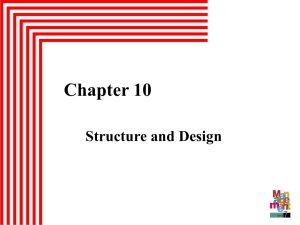
![[SUMMARY] Manajemen (Chapter 10)](http://s3.studylib.net/store/data/008743248_1-4e2b946756cf43cea567b50ee8fe6208-300x300.png)
